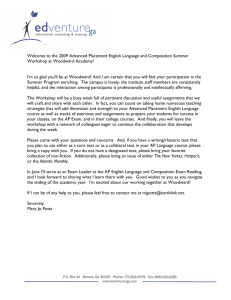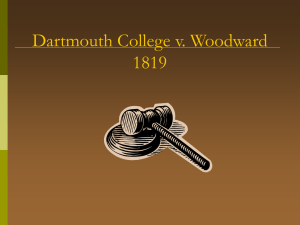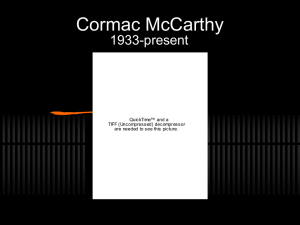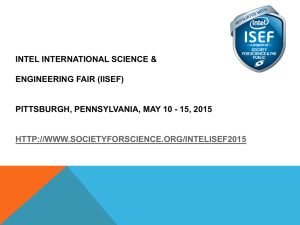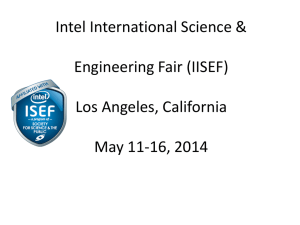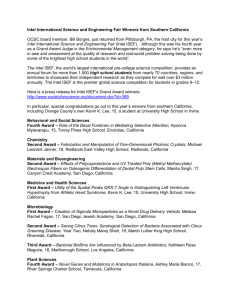Intel Education: Intel ISEF: Finding a Good Project, Where Do
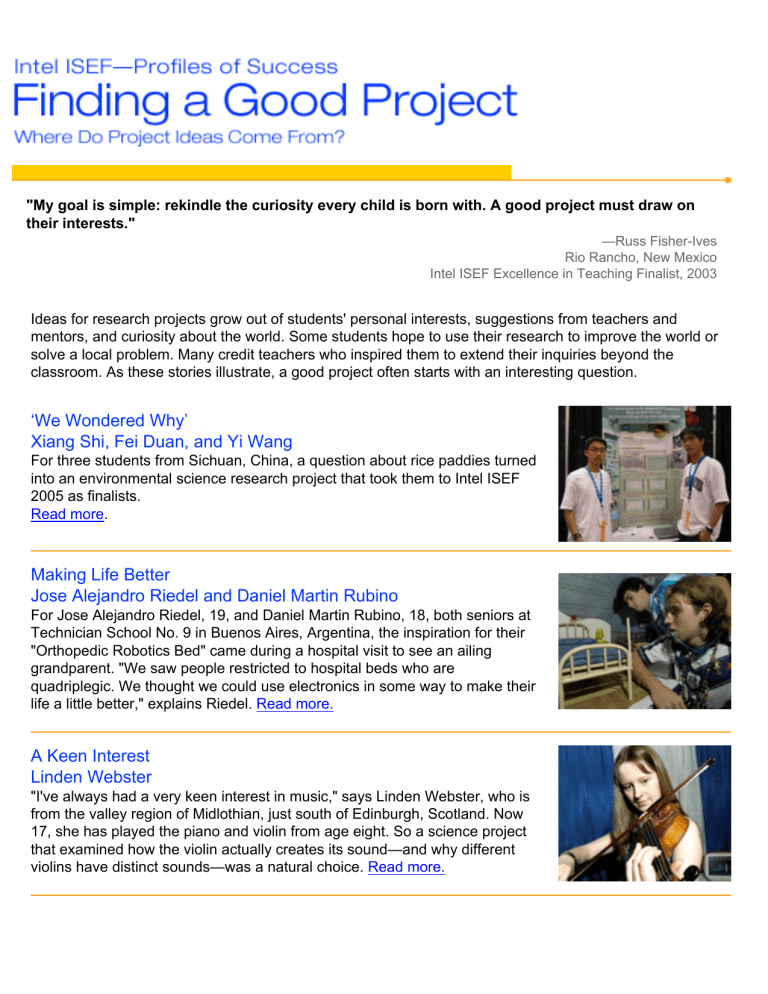
"My goal is simple: rekindle the curiosity every child is born with. A good project must draw on their interests."
—Russ Fisher-Ives
Rio Rancho, New Mexico
Intel ISEF Excellence in Teaching Finalist, 2003
Ideas for research projects grow out of students' personal interests, suggestions from teachers and mentors, and curiosity about the world. Some students hope to use their research to improve the world or solve a local problem. Many credit teachers who inspired them to extend their inquiries beyond the classroom. As these stories illustrate, a good project often starts with an interesting question.
‘We Wondered Why’
Xiang Shi, Fei Duan, and Yi Wang
For three students from Sichuan, China, a question about rice paddies turned into an environmental science research project that took them to Intel ISEF
2005 as finalists.
.
Making Life Better
Jose Alejandro Riedel and Daniel Martin Rubino
For Jose Alejandro Riedel, 19, and Daniel Martin Rubino, 18, both seniors at
Technician School No. 9 in Buenos Aires, Argentina, the inspiration for their
"Orthopedic Robotics Bed" came during a hospital visit to see an ailing grandparent. "We saw people restricted to hospital beds who are quadriplegic. We thought we could use electronics in some way to make their
life a little better," explains Riedel. Read more.
A Keen Interest
Linden Webster
"I've always had a very keen interest in music," says Linden Webster, who is from the valley region of Midlothian, just south of Edinburgh, Scotland. Now
17, she has played the piano and violin from age eight. So a science project that examined how the violin actually creates its sound—and why different violins have distinct sounds—was a natural choice.
A Spectacular Sight
Hana Druckmullerova
Avid astronomers often remember the first time a spectacular sight in the night sky captured their attention and launched them on a career in star-gazing. For Hana Druckmullerova, 18, from Brno, Czech Republic,
it was a sight she couldn't see that ignited her interest in earth and space science. Read more.
Born to Fly
Flannery Elizabeth Woodward
When Flannery Elizabeth Woodward was about three years old, her dad took her to an air show near their home in Beaufort, South Carolina. "We saw a bunch of airplanes, and we saw the Blue Angels fly. And I pulled my hat down and said, 'Dad, you know what? I want to be a pilot. And after that, I want to fly space shuttles.' Every kid dreams of being an astronaut as a small child," she admits, "but my dream stuck with me. Now I'm 16, and I'm the only one in my school who wants to be an astronaut still." When it came to identifying a good science fair topic, Woodward naturally focused her research on the
principles of flight. Read more.
Better Bike Security
Alex Paine
Growing up on a farm in rural Wales, Alex Paine uses a lightweight mountain bike to get around. The best way to keep an expensive bike secure is to lock it with a heavy chain. But lugging around a chain "spoils the ride and makes it pointless to have a light bike," Paine says. So the student from Dyffryn Taf
School in Carmarthenshire decided to design a better bike security system.
For three students from Sichuan, China, a question about rice paddies turned into an environmental science research project that took them to Intel ISEF 2005 as finalists.
Xiang Shi, 17, Fei Duan, 17, and Yi Wang, 17, attend Chendu Number 7 High School in Chendu, Sichuan.
The students noticed that tadpoles occur in smaller concentrations in rice paddies than in streams. “We wondered why,” said Xiang Shi.
That initial inquiry took them in search of experts who could answer their question. “The experts suggested we conduct experiments to find out,”
Xiang Shi explained.
The students designed a study about the behavior of tadpoles, specifically
Rana omeimontis , a rare species of true frog found near Mt. Omei in
Sichuan, China. They collected water samples from different habitats, along with a control group, and conducted observations. They found that not only
Xiang Shi, Fei Duan, and
Yi Wang the concentration of tadpoles varied from streams to paddies, but also that tadpole behavior and distribution was different in the two habitats.
“We found that the water in the rice paddy has influenced tadpoles' living, The behavior (including the patterns of distribution) of Rana omeimontis tadpoles is sensitive to variation of habitats,” they concluded.
Tadpole populations dropped as rice paddy water became warmer and more concentrated with herbicides and pesticides.
The students learned that they are in the company of researchers worldwide who are studying the changing population patterns of amphibians. “Amphibians have many beneficial qualities,” Xiang Shi said.
“In our region, they add to the protection of the rice paddies.” He hopes his team’s research “can be used to help protect animals found in these habitats.”
At Intel ISEF, the students won a fourth-place team award and US$500.
For Jose Alejandro Riedel, 19, and Daniel Martin Rubino, 18, both seniors at Technician
School No. 9 in Buenos Aires, Argentina, the inspiration for their "Orthopedic Robotics Bed" came during a hospital visit to see an ailing grandparent. "We saw people restricted to hospital beds who are quadriplegic. We thought we could use electronics in some way to make their life a little better," explains Riedel.
Their engineering project combines microcontrollers, sensors, and electronics to turn an ordinary bed into a user-controlled environment. Depending on his or her physical abilities, the user can activate signals by using voice commands, tapping on a controller, or blowing into a microphone. Signals are encoded by means of a binary code and, according to the combination received by the device, the order is executed. An order could control mechanics of the bed itself or the environment.
Jose Alejandro Riedel and
Daniel Martin Rubino
"This will allow them to control things like the lights in the room,"
Riedel explains. Users could select music or other electronic entertainment, or change the volume or channel. "To those without disabilities, these may seem like easy things. But to a person who spends all day, every day, in a hospital bed, this makes him a little more independent. This might be a great thing," Riedel adds. Users could also issue commands to make mechanical adjustments while doing rehabilitation exercises.
Months of Effort
Getting from their idea to a working prototype took months of effort. The students built a prototype to determine the mechanical resistance of the bed and test how the force exerted by the motors would work. In addition to solving mechanical engineering problems, they had to solve electronics challenges so that commands could be issued not only by voice, but also by blowing or tapping a microphone.
The teammates said their efforts were worthwhile when they asked a user who is physically disabled to test their communications device. "He was very excited about the possibilities for this," the said.
At the 2004 Intel ISEF in Portland, Oregon, Riedel and Rubino won a fourth-place award of
USD$500 in the team division of engineering.
"I've always had a very keen interest in music," says Linden Webster, who is from the valley region of Midlothian, just south of Edinburgh, Scotland. Now 17, she has played the piano and violin from age eight. So a science project that examined how the violin actually creates its sound—and why different violins have distinct sounds—was a natural choice.
"If these characteristics could be recreated, then one day it might be possible to make a relatively cheap instrument with the sound quality of the best Stradivarius violin," Webster says. "The project was the perfect opportunity to develop this knowledge."
The "tools" for Webster's research were close at hand: four violins that she owns, ranging from very small to full size, and varying in sound quality.
Important Connections
Once Webster had defined her project, her headmistress at Beeslack
Community High School helped arrange a scholarship that allowed
Linden Webster the student to spend five weeks during summer vacation at the School of Electrical
Engineering and Electronics at Edinburgh University. There, Webster faced her biggest challenge: learning to use and program a computer.
But she also found two helpful mentors. "Dr. John Thompson taught me the best way to input my sound signals and prepare them for analysis," says Webster. "Dr. Raymond Parks, an expert on acoustics, guided me on the best way to make my recordings. He also gave me the amazing opportunity to look at some rare and unusual instruments in the university's musical instrument collection."
Learning to Communicate
Back home, Webster continued to work on her own, outside school hours. "Within a school environment it's easy to get help with things when small disasters occur, but if something goes wrong while working on your own, it becomes your responsibility to put the problem right," she says. "This experience has taught me a lot about self-motivation."
In early 2004, Webster took her project, "Discrimination of Violin Qualities through Frequency
Time Analysis," to the prestigious British Association CREST Science Fair in London, where it was a joint winner. "The fair was a great opportunity to meet new people, many of them interested in the same field and enthusiastic about their projects," she says. "I also learned how to communicate better about my research."
At ISEF 2004 in Portland, the cheerful tunes coming from Webster's booth needed no explanation. Crowds gathered around to hear her play and ask questions about her project.
She won a fourth-place award, and US$500, in the physics category.
Webster plans to study physics at Oxford University next year. She also hopes to keep playing music, "but now with a much better understanding of how my violin creates sound."
Avid astronomers often remember the first time a spectacular sight in the night sky captured their attention and launched them on a career in star-gazing. For Hana Druckmullerova, 18, from Brno, Czech Republic, it was a sight she couldn't see that ignited her interest in earth and space science.
A student at Gymnazium, Brno-Reckovice, Terezy Novakove 2, Druckmullerova witnessed her first total solar eclipse in 1999. She accompanied an expedition to Hungary for the event.
Expedition members used special optical equipment to record images of the eclipsed sun.
However, results captured only partial views of the event rather than generating a single image with information about the whole solar corona. As Druckmullerova explained, "A composite white light image of the solar corona, which can be obtained only during the total solar eclipse, includes much information about its structure, but it is not visible."
Analyzing the Solar Corona
She set out to write a computer program, using mathematics to make the corona imagery visible and allow for further analysis. The programming task proved challenging. "Every day I had to go to school and then I tried to add some ideas to the program. It was not easy to understand the commands I had written several weeks before."
She consulted with experts in numerical methods of image analysis at the Institute of
Mathematics, Faculty of Mechanical Engineering, Brno University of Technology. "Their knowledge helped me solving the problems of solar corona image analysis," she said. Her father, a mathematics professor and amateur astronomer, also provided encouragement during the long months she devoted to her project.
What kept her motivated? "Every day I was programming, I was thinking about the day on which I would see the result of my program—an image with the interesting coronal structures.
The first moment I saw this image was one of the most exciting moments of doing my project."
At the 2004 Intel International Science and Engineering Fair (Intel ISEF), visitors gazed at
Druckmullerova's exhibit to see the graphic results generated by her program, which she named Corona. Attending Intel ISEF as a finalist in Portland, Oregon, was Druckmullerova's first trip to the United States.
Druckmullerova continues to be interested in solar astronomy and hopes to witness another total eclipse in Turkey in 2006. Going on a research expedition, she said, "is a great experience. Then I would like to compare the coronal structures of the eclipses during the solar activity cycle."
She plans to study mathematics at Brno University of Technology, then pursue a career in
programming using mathematical algorithms.
When Flannery Elizabeth Woodward was about three years old, her dad took her to an air show. "We saw a bunch of airplanes, and we saw the Blue Angels fly. And I pulled my hat down and said, 'Dad, you know what? I want to be a pilot. And after that, I want to fly space shuttles.' Every kid dreams of being an astronaut as a small child," she admits, "but my dream stuck with me. Now I'm 16, and I'm the only one in my school who wants to be an astronaut still."
When it came to identifying a good science fair topic, Woodward naturally focused her research on the principles of flight. As a junior at Beaufort High School in Beaufort,
South Carolina, she conducted an engineering project that earned her regional honors and a chance to compete as a finalist in Intel ISEF 2003. Her project, "Newton vs.
Bernoulli: Who Can Lift It? An Analysis of the Components of Lift," involved conducting tests in a wind tunnel, interviewing aeronautical engineers, and challenging some long-held assumptions about flight.
Getting Started
Woodward launched her research by visiting a flight museum near her home. "I saw a wind tunnel there. I asked who had made it and how I could get my hands on it."
She knew what she wanted to test: "All the books that I've read about flight attribute the lift that keeps the airplane in the air to
Bernoulli's Principle, which says that the air moves faster across the top of the wings. There's going to be lower pressure there causing it to rise. I'm a physics student this year, so I learned about Newton's
Laws of Motion. I wanted to make Newton's Laws apply to flight because I knew there had to be some connection. I wanted to put some airfoils in the wind tunnel and test my theory."
Woodward learned that the museum wind tunnel was made by engineers from Gulf Stream, which manufactures small planes and
Woodward tested five airfoil sections.
corporate jets. She obtained permission to use the wind tunnel for her research. From studying books about flight, she knew about different kinds of airfoils. She worked out her specifications and made her airfoils so they would fit inside the testing area. "I picked an airfoil like you'd see on a jet and also something you'd see on a propeller airplane, so I'd have two different extremes," she explains. Eventually, she created five airfoil sections to test.
Her Learning Curve
Conducting the tests meant learning how to take lift and drag readings. "I had to go through that learning process, but once I figured out how to use the wind tunnel, then it was really easy to just collect my data, a bunch of numbers I had to write down." She describes her testing process: "I calibrated force probes to translate volts into ounces of lift and drag. I used a Pitot tube to measure airspeed in the wind tunnel. First, I recorded the airspeed in clear air to make sure that it would remain constant. Then, I recorded airspeed above and below the airfoil sections. Finally, I recorded the lift and drag being created."
After the first couple tests, Woodward admits, "it started getting monotonous. I had to run five tests of each airfoil at each angle of attack, and so that equals 10 tests per airfoil. And that's five airfoils, so that's 50 tests."
What kept her motivated? "Tasting the science fair, knowing that if I do this project the right way, then maybe
I can come to Intel ISEF."
Once she had collected her data, Woodward was ready to take the next step and "reason my way through it.
What does this mean? What does that mean?" She interviewed aeronautical engineers for more insights. An engineer from Gulf Stream was particularly interested to see her challenging conventional wisdom. "He was really excited to see that somebody was pushing the limit. I mean, if somebody just accepts things blindly, then nothing will change. Someone has to go out there and figure out what could be new, what can you add on, what can be changed. He was excited to see a student doing that."
Ideas and Implications
After analyzing her data, Woodward concluded that "the textbooks don't give Newton's Laws enough credit for the real job they do in keeping the airplane in the sky. And I think it also speaks a little bit about the kind of wings that are needed for a faster-moving and a slower-moving airplane. That is explained a little bit more by my project."
Although the competition has ended, Woodward isn't finished with her research. "Next, I want to test birds of prey in a wind tunnel. I want to look at their gliding capabilities compared to gliders that our military uses for its special operations, and see if there's any way that we can better the gliders that we have to make them fly faster and let us have more control over where they're going." She won't be studying just the wings, but "the whole bird, including its wing structure, tail structure, the streamlines of the body." She plans to work with specialists from a university veterinary school to design an appropriate experiment.
The Intel ISEF Experience
Although Intel ISEF 2003 was Woodward's first chance to compete at the international level, she watched the event from the sidelines in 2000. "I won at the middle school fair, and the prize was getting to attend Intel
ISEF as an observer. That was an excellent opportunity for me to get my feet wet and know that I really wanted to come back as a finalist."
Although Woodward admits that the judging is "a little nerve-wracking at first," she enjoys the chance to talk about her research with knowledgeable experts. "Having judges who know about aeronautics is extremely helpful."
Throughout the process, Woodward has drawn on the support of her parents and her teachers. "My dad has been my cheerleader all along. He was a pilot, so he understands what I'm doing. And my mom has been supportive, too. My teachers have encouraged me to work hard on my project and to make it of a higher caliber so I could come and compete. And I think having those two influences has been wonderful."
In terms of long-range plans, Woodward still has her eyes on the skies. "I haven't given up on my dream of flying. I'm determined that I'm going to go to Mars someday. I'm not letting that dream go. It keeps me motivated."
Growing up on a farm in rural Wales, Alex Paine uses a lightweight mountain bike to get around. The best way to keep an expensive bike secure is to lock it with a heavy chain. But lugging around a chain "spoils the ride and makes it pointless to have a light bike," Paine says. So the student from Dyffryn Taf School in
Carmarthenshire set out to design a better bike security system.
His design specifications grew more specific as he thought about what he wanted his product to accomplish. As he explains, "First I thought I'd make a bike alarm. But if someone nicks your bike and the alarm goes off, they just leg it." So he came up with the idea of designing a sensor with a remote alarm. "My idea was to have the sensor on your bike and the alarm in your pocket, so you know [when the alarm goes off] but the thief doesn't."
Designed to Fit
The design Paine developed uses a radio signal that is transmitted to a box small enough to fit into the owner's pocket. "It's an encoded signal in a radio transmitter, so the actual sensing device is a movement sensor." When the sensor detects movement, the device sends data by radio waves which are picked up and decoded, sounding a buzzer. Paine came up with the design "by messing up all the time and making some improvements because it kept not working. Just thinking—thinking through how you do stuff, and eventually you get the answer."
One of his biggest challenges was making the security device small enough to fit inside the bike. "There's nowhere really to put it," he says. The space that made the most sense? Inside the seat post. But that meant working out some precision engineering issues. Paine became the first student at his school to use new computer-aided design/computer-aided manufacturing facilities, known in industry as CAD/CAM. "It's about as small as I could make it with the facilities I had," he says.
Gathering Ideas
Entering his project in competitions has given Paine new ideas for future problem solving. He has enjoyed the opportunities to talk with "people who know a lot about the stuff you've done." He won a second-place award at the Wales Student Innovations Awards, then took his project on to London for the 2003 BA
CREST Science Fair. "There are so many clever people here," he said at the fair. "You put all the clever people together in one room and everything sort of builds up, and you solve things very easily then."
